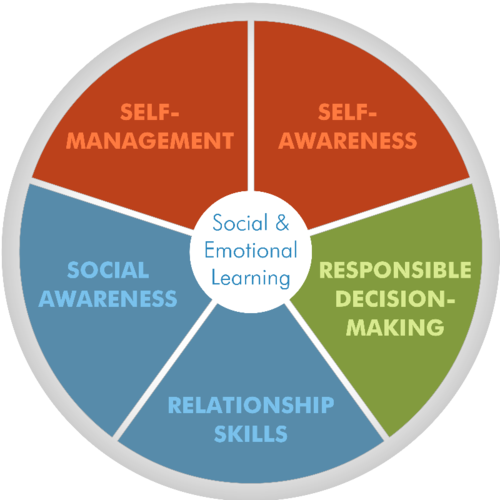CASEL (the Collaboration for Academic, Social, and Emotional Learning) describes it as a
process through which children and adults acquire and effectively apply the knowledge, attitudes, and skills necessary to understand and manage emotions, set and achieve positive goals, feel and show empathy for others, establish and maintain positive relationships, and make responsible decisions.
The five SEL competencies:
(© 2015 CASEL)
In reference to the above competencies, SEL should
increase students’ abilities to recognize emotions and emotional triggers, make and identify personal and academic goals, demonstrate cooperation and teamwork, and identify ways to resist peer pressure to engage in unsafe or unethical activities. (CASEL, 2015)
The authors of one of the largest studies ever done on social emotional learning add that “the SEL approach integrates competence-promotion and youth-development frameworks for reducing risk factors and fostering protective mechanisms for positive adjustment” (Durlak et al, 2011)
The ideas behind SEL are by no means new. In his 1995 book Emotional Intelligence, Daniel Goleman provides “evidence for social and emotional intelligence as the complex and multifaceted ability to be effective in all the critical domains of life, including school.”(Elias, 1997)
Elias (1997) also provides examples of how SEL can assist students to be “effective in all the critical domains of life”:
“Recognizing emotions in self and others”
“Regulating and managing strong emotions (positive and negative)”
“Recognizing strengths and areas of need”
“Listening and communicating accurately and clearly”
“Taking others’ perspectives and sensing their emotions”
“Respecting others and self and appreciating differences”
“Identifying problems correctly”
“Setting positive and realistic goals”
“Problem solving, decision making, and planning”
“Approaching others and building positive relationships”
“Resisting negative peer pressure”
“Cooperating, negotiating, and managing conflict nonviolently”
“Working effectively in groups”
“Help-seeking and help-giving”
“Showing ethical and social responsibility”
What is it in practice?
According to CASEL, “social and emotional learning…provides a common language and coordinating framework for communicating not just about SEL but about a wide range of programs and teaching approaches that schools normally provide.” (CASEL, 2015). This means standalone courses in SEL, integration into lessons and units, school and district policy, extracurricular activities, and student-teacher relationship-building (more detail can be found here: http://secondaryguide.casel.org/#Approaches).
SEL takes place in every realm in a student’s life: classroom, school, family, social networks, and the wider community. It is part of a child’s socialization, which is uniquely coloured by relatives’ personalities, lifestyle choices, cultures, ages and many other factors. It is mostly informal and experiential, but schools are now adopting formal instructional strategies in- and outside of classrooms. I believe there is a need for formal SEL strategies over informal, because they are more likely to produce measurable and reliable results. As an educator, I want to assess my students’ social emotional competencies against clear rubrics. The draft BC Curriculum has provided such rubrics, which can be viewed here: https://curriculum.gov.bc.ca/sites/curriculum.gov.bc.ca/files/pdf/PersonalAwarenessResponsibilityCompetencyProfiles.pdf (last page of the document).
SEL equivalents around the world
Article 27 of the UN Convention on the Rights of the Child
1. States Parties recognize the right of every child to a standard of living adequate for the child’s physical, mental, spiritual, moral and social development.
2. The parent(s) or others responsible for the child have the primary responsibility to secure, within their abilities and financial capacities, the conditions of living necessary for the child’s development.
3. States Parties, in accordance with national conditions and within their means, shall take appropriate measures to assist parents and others responsible for the child to implement this right and shall in case of need provide material assistance and support programmes, particularly with regard to nutrition, clothing and housing.
(source: United Nations)
The phrase social-emotional learning is a US-centric concept, but the idea exists around the world. It is crystallised in international law, as shown in Article 27 above.
Fragments of SEL swirl around under different labels, such as character-building, non-formal learning or pastoral care. In a 2014 interview with The Atlantic magazine, the Finnish Education Minister said
academics isn’t all kids need. Kids need so much more. School should be where we teach the meaning of life; where kids learn they are needed; where they can learn community skills. We like to think that school is also important for developing a good self-image, a strong sensitivity to other people’s feelings … and understanding it matters to take care of others. We definitely want to incorporate all those things in education. (Gross-Goh, 2014)
Unlike the other labels, SEL fully describes its mandate. It is also has defined outcomes and assessment strategies, which other labels often lack. I do not intend to portray, for instance, character-building as unable to achieve the same outcomes; rather, SEL as a field of study applies methodical rigour to a traditionally ambiguous subject.
